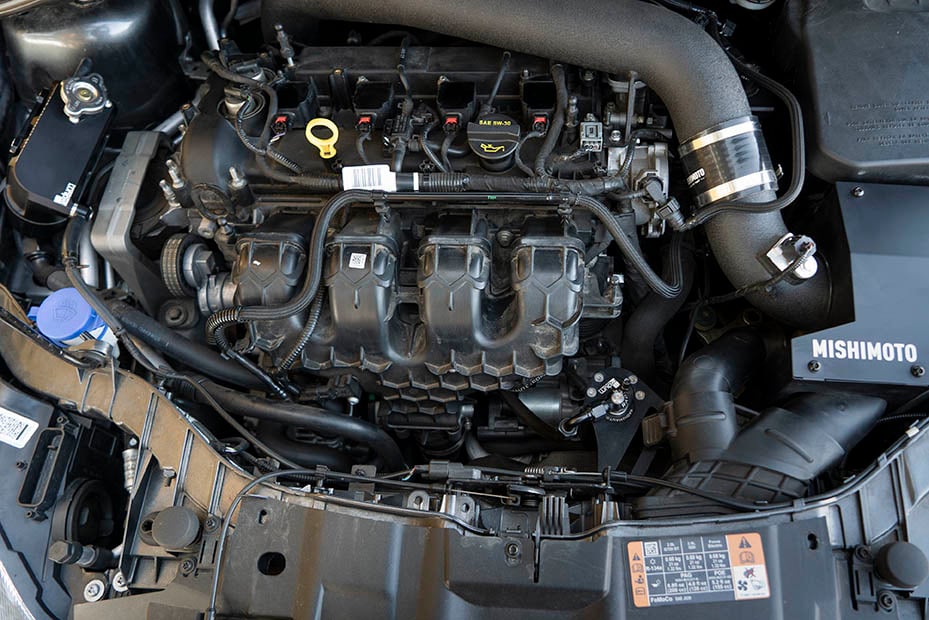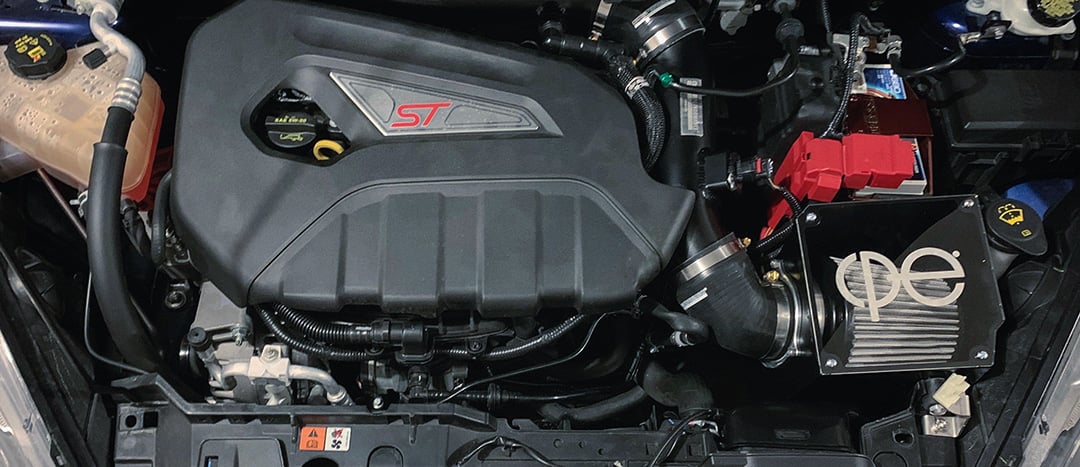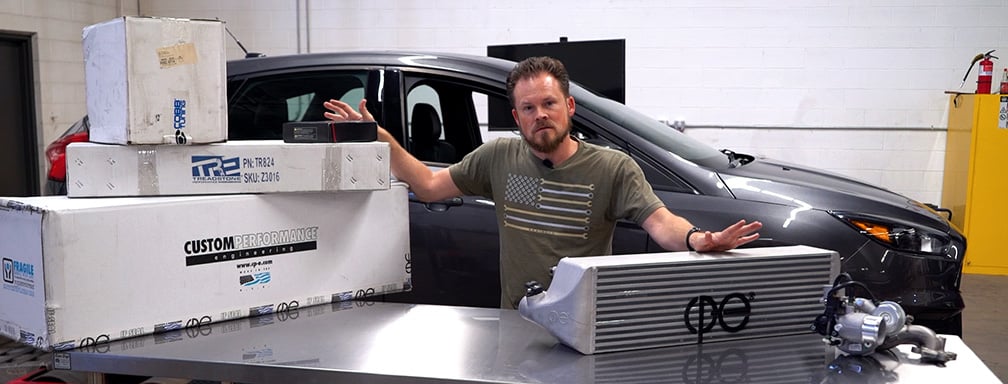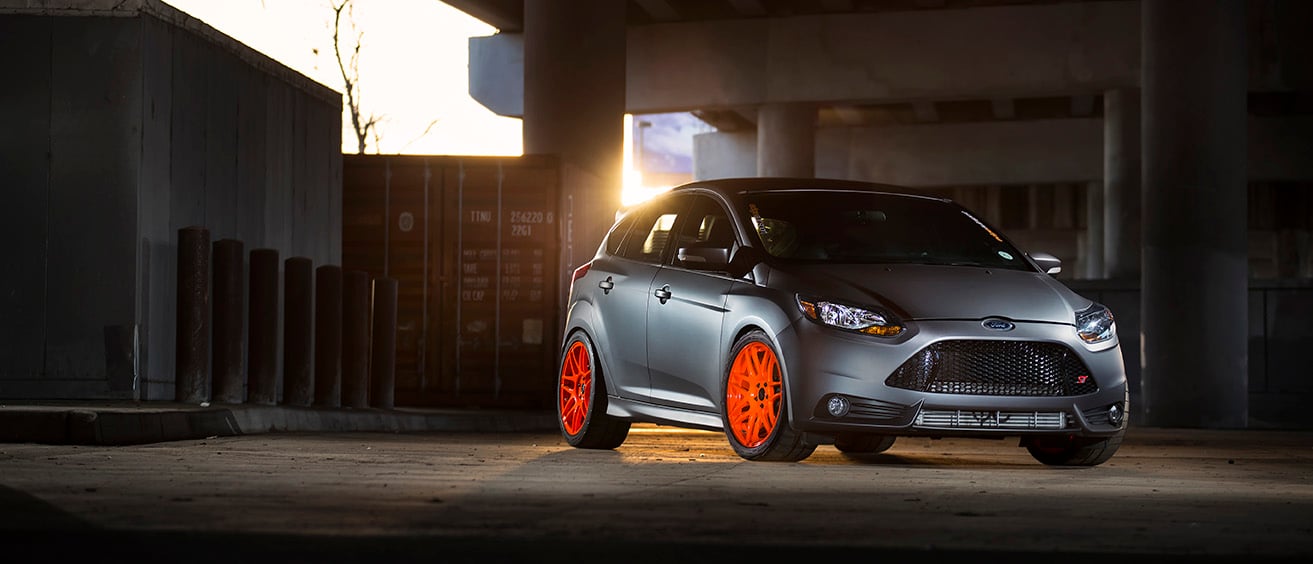.jpg?width=1024&height=299&name=Putting%20Down%20400whp%20In%20Your%20Focus%20ST%20(2.1).jpg)
400whp (that's wheel horsepower just in case you've been living under a rock) seems to be the magic number in front wheel drive turbo cars. If you have one, you know what I mean. If you want one, it's probably because 385whp is way too close to 400 for you not to get there. It's almost like being in a club. "It has 400 at the wheel." It's one of the most proud statements you can make if you have a Focus ST and it's making that much power.
500+ horsepower is worth bragging about too. But it gets complicated, expensive, and risky. With better tires than stock and some basic chassis and drivetrain modifications to help your car grip during acceleration, 400 is just the right amount of power that features a turbo that can still spool relatively quickly and lay the smack down on almost any showroom crowd pleaser costing $70k+. But what's involved? How do you do it without turning your reliable turbocharged grocery getter into a living nightmare taking space up in your garage with a hole in the side of the engine?
Believe it or not, it's relatively easy to do on the Focus ST. I can't say it's cheap because that's dependent on your budget. But we're here to tell you it's attainable with any modest budget.
.jpg?width=640&name=Putting%20Down%20400whp%20In%20Your%20Focus%20ST%20(5.1).jpg)
The Basics
If you haven't been introduced to the basics of modding your Focus ST, check into these mods. In our opinion, you should not try to attain 400whp without these upgrades.
- Cobb AccessPort
- Intake
- Intercooler
- Downpipe
- Exhaust
- Blowoff Valve
- Rear Engine Mount
- 1 Step Colder Spark Plugs
- Sound Symposer Delete (I'll tell you why shortly)
There are a handful of other items we highly recommend but this is the bare minimum. Yes, you need a bigger turbo which we'll get to shortly, but we're specifically referring to supporting modifications here.
A couple notes about the parts above - you NEED a different blowoff valve with any non-BorgWarner EFR turbo. Whether it's a Garrett, Precision, or other brand that you're customizing around, you'll need to get a completely new blowoff valve setup. The Focus ST comes with a blowoff valve built into the turbo which means when you replace it, you need to source a new BOV. This also means you need to source at least one of the 2 intercooler pipes since that's where the new BOV will be located. These are all readily available in kits with a few different blowoff valve options.
The sound symposer delete is the easiest way to create a vacuum/boost source for your BOV. Most people that mod their ST want it gone anyway, but this gives you a really good reason to do such a simple modification.
The Turbo Upgrade
.jpg?width=780&height=238&name=Putting%20Down%20400whp%20In%20Your%20Focus%20ST%20(6.1).jpg)
.jpg?width=780&height=338&name=Putting%20Down%20400whp%20In%20Your%20Focus%20ST%20(7.1).jpg)
This isn't optional, you need a bigger turbo. Luckily, there are many options for you to choose from. Here's a quick rundown of all the turbo options with an estimation of how much power they'll each be able to produce at the crank without considering the supporting modifications needed to get there. These are manufacturer estimations and are completely dependent on each platform. Plan on getting about 10-15% less power when measured at the wheels.
ATP Turbo was the first to come out with a bolt-on solution based on Garrett's GT and GTX style turbos and it's truly "bolt-on". It fits with virtually all intake kits made for the Focus ST and it fits any stock style downpipe. It comes with all hardware you need for installation. Basically, you're swapping out the turbo only. All of the ATP kits feature a port on the top of the turbine housing adapter for using an external wastegate which is a better method of boost control that the smaller, integrated internal wastegate. It comes blocked from ATP but you can remove the vband blanking plate and use a Tial 38mm or Turbosmart 40mm v-band wastegate. There's actually a bolt-on dump tube available from 3P Performance to complete this setup without any custom fabrication needed on your part. Of course, you can opt to keep the internal wastegate and never upgrade it to external. Many people keep the internal wastegate and it works well.
Since the release of ATP Turbo's original Focus ST turbo kits, Garrett has come out with the very high flowing G-Series performance turbos. This is Garrett's next iteration of the highest performing turbochargers they offer after the GTX Gen2 turbos. ATP made sure to conform their already hugely popular bolt-on kit to mate with the G-Series G25 and G30 versions, which make anywhere from 550hp to 770hp. With these specific kits though, they require the external wastegate and do not come with an internal wastegate option.
|
ATP Turbo Options (All Garrett)
*For 400whp, we do not recommend the GT2860RS or the GTX2860. We listed these just to show all ATP options. All other listed turbos will reach 400 or more. |
BNR is the newest member of the Focus ST big turbo kit club with their ST67 and ST71 kits. These are very similar to the ATP Turbo kits with the exception of the turbo adapter to the head. It does not feature an EWG port and will need to stay internally gated.
|
BNR Turbo Options ST67 (475hp) |
As of now, Mountune is the only brand that produces a BorgWarner EFR turbo kit. It features all the hardware you need for installation. Mountune allows you to choose between the 6258, 6758, and 7163 turbocharger options. If you're truly shooting for 400whp, I'd skip the 6258 as it is stretched too far at that point, in my opinion. But for 350whp or slightly more, it's a great turbo.
|
Mountune Turbo Options (All BorgWarner EFR) |
The ultimate turbo kit, which features a stainless steel Tial turbine housing on a Garrett turbo, Tial 44mm wastegate, a cast turbo adapter, and every single part that you need to install the turbo kit, is made by cp-e. In addition, you can actually pick your turbine housing A/R which adjusts where you want the power to be made. If you're shooting for quick spool and don't care about top end as much, pick a smaller A/R. If you're shooting for top end only and want the highest power level possible while losing a bit of spool, pick a bigger A/R. In addition, if you decide you want to get a different turbo down the road, you can. For example, let's pretend you get a GTX3076R and the next year, you want to change to a GTX3582R Gen2 setup. All you need to do is get a new turbo and swap them out. All components still line up. This kit is a home run and will outperform most anything out there along with being the most technically sound turbo kit. We can't begin to describe how awesome this turbo kit is. Yes, it's the most expensive. Yes, it's the best one available. To date, this kit is used on the some of the fastest and most powerful Focus ST's in existence.
|
cp-e Turbo Options (All Garrett)
|
.jpg?width=780&height=519&name=Putting%20Down%20400whp%20In%20Your%20Focus%20ST%20(4).jpg)
Fueling
Since the original publishing of this blog, Xtreme DI has entered into the mix with a few different mechanical fuel pumps and a set of higher flowing injectors. We'll start with that and then dip into auxiliary fueling next. Before we go further, the reason why fueling is part of this conversation is because the stock fuel system is limited to around 350-375whp. So for a proper 400whp build, fueling upgrades are required.
High Pressure Stock Fuel System Upgrades
Direct injection presents challenges not seen with port fuel injection. For a long time, complete fuel system replacement options weren't available. But lucky for everyone in the Focus ST world, XDI has provided the solution. At this point in time, XDI makes 2 different mechanical fuel pumps (HPFP or CDFP for short) and a set of upgraded injectors. Depending on the combination of fuel upgrades you use and your power goals, you may just need to upgrade the pump and not the injectors. But for those wanting the most power you can get and have the turbo to support it, replacing both yields the highest potential. If you're shooting for 400whp, an upgraded pump of any kind will do the trick by itself. If you're planning on keeping the stock injectors, we recommend the EVO as it will be able to generate more pressure and overcome the more limited factory injectors. This will yield about 400-420whp on E30 fuel blends. If you get the upgraded injectors, you can use those with the HPFP35 to extend the fuel system's power range to about 500whp on E30 and about 450whp if you choose to use full E85. The EVO pump does not yield you any more power since the upgraded injectors are best suited for a lower pressure and do not benefit from the extra pressure the EVO pump can generate.
|
XDI Fuel Pump Options HPFP35 - 36% Flow Increase, Up to 2600psi XDI Injectors 2,000cc/min flow rate at 100bar (1,450psi) |
Auxiliary Fueling Upgrades
Auxiliary fueling is the second option and the only method available prior to XDI releasing their fuel pumps. Auxiliary fueling is the process of adding fuel injectors onto your current fuel system and controlling them with a secondary fuel controller. It's not as convenient and requires more physical parts and setup than just replacing a pump and injectors. Ultimately, there are two reasons why some people choose this route. It can be less expensive and it will get you the highest level of power. You can even use this in conjunction with XDI fueling upgrades too. It's the fueling modification that sort of takes the ceiling off of any stock style fuel system.
Stratified Auto's throttle body port injection system is the simplest way to setup an aux fuel system on your ST. This adds 2 injectors at the throttle body location and sends fuel through the intake manifold to mix with the air going into the cylinders. This extends the range of your power significantly.
Stratified also offers a 4-port auxiliary fueling kit that adds an adapter between the cylinder head and the intake manifold to spray 4 extra injectors worth of fuel into the cylinders, 1 per cylinder for a nicely distributed flow pattern.
.jpg?width=780&height=352&name=Putting%20Down%20400whp%20In%20Your%20Focus%20ST%20(8).jpg)
In-Tank Fuel Pump
Although the OEM in-tank, low pressure pump cranks out a good amount of fuel when asked, it's also limited to about 500whp depending on what fuel you're using. The more ethanol you're using, the more demand it creates on the pump. It's a safer bet to upgrade the in-tank fuel pump so you're not close to the limitation of the pump. Without getting too much into it, you can either replace the OEM pump inside the tank or you can add on the Radium surge tank kit that adds a new fuel pump and the functionality upgrade of a surge tank at the same time. It's not the cheapest way to get a new low pressure pump in the car but it's definitely a complete upgrade. And since there is no true "drop-in" fuel pump to replace the in-tank unit, you need to be somewhat competent being able to modify the stock fuel pump assembly.
Since the stock fuel pump is capable of that much, you don't absolutely have to do this upgrade to make really good power, but it's not a bad idea. The Radium setup adds functionality and not just more fuel flow.
Fuel Type
400whp requires better fuel than what's at your local grocery store gas station. It's generally not acceptable to look for the cheapest gas station. Either way, getting there on the best pump gas alone isn't realistic and even if you could, you're riding the edge of a dangerous limit to what pump gas is capable of. It doesn't have the properties that help control what's happening inside the cylinder. Too much heat, a bad mixture at a random gas station, or too low of an octane can be a recipe for disaster. There are 2 easy ways to get around this.
The most popular way is blending ethanol (E85) with your pump gas. Ethanol has awesome cooling and knock prevention properties. It's basically race gas available at the pump. Honestly, it's probably better than most race gases out there. Running full E85 is not the best idea for a couple reasons but you can run up to about 50% of a mixture of ethanol and regular gas. With ethanol in your tank, your tuner is able to raise your timing values, run more boost, etc. Because of the fueling limitations of the car, the car will make the most power it can without going all the way to E85. You'd actually make less by using that much ethanol.
If you do not have access to ethanol or another race gas, you simply should not be shooting for 400whp or more. Better fuel is a requirement. There are a handful of turbo setups out there that will do it because of their efficiency. But it's not realistic for about 99% of big turbo setups.
The next option is methanol injection. There are many quality methanol/water injection kits available with different size nozzles for different amounts of methanol to be injected into the intake system. This is a simpler type of auxiliary fueling that sprays methanol into the intake system before it hits the cylinders. It cools down the intake air and increases the octane of the fuel mixture in the cylinder. Just like ethanol, it allows you to run more boost and more timing, among other things, to achieve more power than pump gas alone allows. Meth injection can help you get to 400whp but it's a cheaper alternative. If you do this, you can potentially avoid the aux fueling setup. However, we recommend the aux fuel over this if we had to pick one or the other. Methanol injection isn't as reliable or convenient as auxiliary fueling and doesn't compare to the XDI components mentioned above. If you have the means to get the first two options, that's the way to go. A methanol injection kit can still provide benefits even when used with the other two methods.
Tuning
400whp requires tuning. You probably already knew that. Just to reiterate though, you cannot put a bigger turbo on your car and use a better fuel like ethanol without having a professional tuner calibrate your ECU. A dyno tune is an ideal way of getting this done as it takes the shortest amount of time and can be done in a controlled manner. It's safe and doesn't brake any laws. Score 1 for dyno tuning. Being tuners ourselves, we understand that tuning your car on the street is just a more realistic scenario for some. The benefit is it can be very accurate because you're getting to see how the car is actually loading up the engine when it's in a real world scenario, unlike the dyno. Score 1 for street tuning. Either way, properly calibrating your ECU is not optional.
On the subject of tuning, if you're running an auxiliary fueling setup, you'll need to tune a second device, usually a Split Second Controller or something similar. This is what controls the extra injectors and it's a more simple ECU. So you need to tune that alongside your car's main ECU. Somebody with specific auxiliary tuning experience becomes very important here.
Do you have to build your engine?
Many of you are aware that adding about 200 horsepower to your Focus ST is stressing it out just a little more than how it came. We can't say you need to build your engine but we can't say that you don't either. It's really at your own risk. For the record, 400whp is our comfortable limit on a stock engine. Anything more and we recommend reinforcing your engine with better internals. But here's what you need to know. There are many stock engine ST's running around with 400whp for many thousands of miles. There are ST's that have also blown up within the first few drives. What we've experienced is that the fresher and healthier your motor is, let's say no more than 60-70k miles, the safer it is to push the limit. If the car had an issue before you put a big turbo on, it's only going to get exposed further (and probably quickly). The most important variables are your ECU tune, the quality of the installations/parts, and the health of your engine. Don't take shortcuts.
One other thing, if you don't take care of your car, it doesn't matter how much power it has in it. You're going to screw it up. So treat it like you paid thousands of dollars for the car and mods because you did. Change the oil, check the compression, swap the spark plugs out when they need to be, change the belts, do what it says in the manual and maybe a little more now that you're modded and your car will be nicer to you than if you didn't.
Housekeeping

Everything up to here is the meat and potatoes of the build, but there are many other useful parts and ideas, some being required or highly recommended. We have written about them elsewhere but we'll give you the quick rundown of what else you should think about.
- A PCV plate and two catch cans - highly recommended
- Brake upgrades - pads and rotors at the least
- Upgraded clutch - if you don't now, you'll need to soon
- Limited Slip Differential - a good idea while getting a new clutch
- Better tires - doesn't get talked about enough
- Stiffer, lower suspension will help your car make better use of the power but that's up to you and it's not critical. You're still going to have a ton of fun even on stock suspension.
- Different ECU maps for different fuel - if you're traveling and don't have E85 available easily, you'll need to run a pump gas map
This post was originally published in September, 2017 but has been updated to reflect current parts and accurate information!
I'm the founder of Edge Autosport and I remember first getting into cars in high school. I read all the magazines, bought a bunch of technical books, and finally got to start wrenching around the age of 19. I really enjoy modding and being able to live out a passion is truly awesome. I wouldn't change a thing.
Topics:


%20-%20Does%20Your%20Big%20Turbo%20Need%20It/EWGKit-web-(2).jpg?width=1018&height=449&name=EWGKit-web-(2).jpg)












